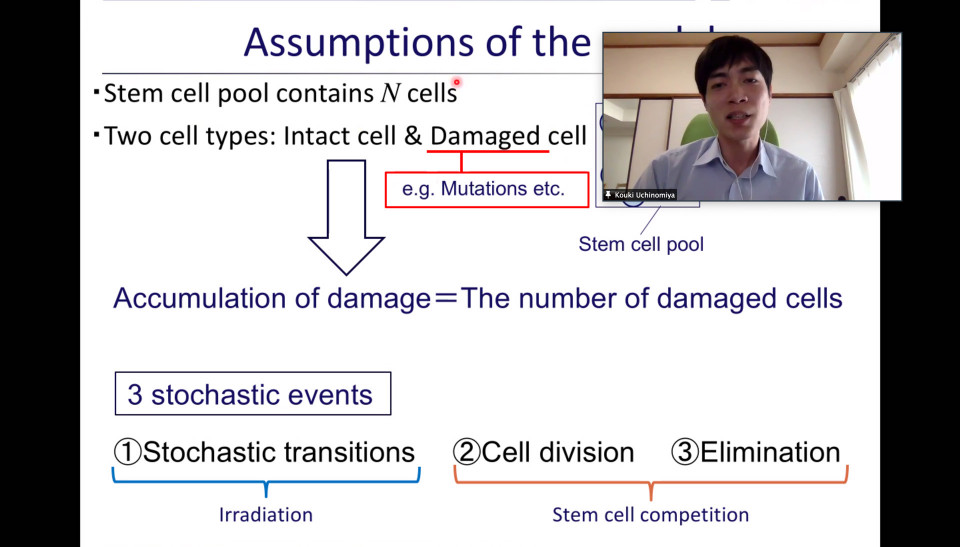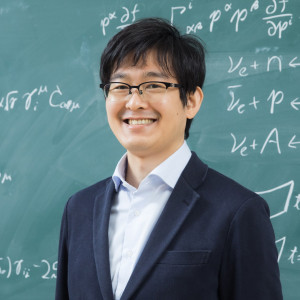Volume 152
Back to Newsletter List
Event Schedule
Events for the 1st week of June 2021
2021-05-27
Thursday, June 3, 10:00- iTHEMS Biology Seminar
Friday, June 4, 11:30- Coffee Meeting
Press Release
First Clarification of the Network Structure of Money Flow
2021-05-27
A collaborative research group, including Prof. Hideaki Aoyama (Senior Visiting Scientist, iTHEMS), has successfully used the latest big data network science to understand the structure of money flows between corporate accounts at regional banks.
See related link for details.
Reference
- Yoshi Fujiwara, Hiroyasu Inoue, Takayuki Yamaguchi, Hideaki Aoyama, Takuma Tanaka & Kentaro Kikuchi, Money flow network among firms’ accounts in a regional bank of Japan, EPJ Data Science 10, 19 (2021), doi: 10.1140/epjds/s13688-021-00274-x
Seminar Report
iTHEMS Biology Seminar by Dr. Kouki Uchinomiya on May 27, 2021
2021-05-27
On May 27 (JST), we had online talk by Dr. Kouki Uchinomiya at iTHEMS Biology Seminar. He was one of active members of RIKEN iTHES, and currently he is at Central Research Institute of Electric Power Industry in Tokyo. This time, Kouki talked about radiation and cancer risk.
Radiation can cause DNA damage for which it can cause cancer in our body. In the field of radiation and cancer, there has been a mystery that cancer risk decreases as the dose rate of radiation (Gy/h) decreases while the total dose of radiation fixed. By incorporating the competition between the normal and the damaged cells by radiation into a simple mathematical model, he successfully explained the mysterious phenomena. His model revealed that the key parameters including a relative reproductive ability of the damaged cells determine the cancer risk. According to him, those parameters will be experimentally measured in the near future, and we understand that the model should contribute to the quantitative estimation of cancer risk by radiation.
During and after the talk, there were stimulating discussions as for the philosophy behind his very simple model and a possible extension to the model with the effect of immune system. We enjoyed his concise talk very much. Thanks Kouki!
Reported by Gen Kurosawa
A Mathematical Model for Stem Cell Competition to Maintain a Cell Pool Injured by Radiation Exposure
May 27 (Thu) 10:00 - 11:00, 2021
Seminar Report
Math Seminar by Dr. Michiya Mori on May 24, 2021
2021-05-27
On May 24, there was an iTHEMS math seminar by Dr. Michiya Mori.
In the first part, he explained his research on Lowebner theorems. He first described the notion of abstract order. He then introduced an order on the space of the hermitian matrix. He explained Molnar's results that the order-preserving map must be affine on a particular good subset of matrices. Lastly, he explained his results with his collaborator that a map on matrix domain is an order isomorphism if and only if it has a good extension to the upper half-space.
In the second part, the speaker introduced the projective Hilbert space, the space of all quantum states, and Fubini-Study metric, an "argument" on the projective Hilbert space. He then introduced the result by Wigner that any bijective maps preserving Fubini-Study metric are unitary or anti-unitary. The speaker introduced Uhlhorn's variant of this result: if the dimension of the space is larger than three, any bijection preserving argument π/2 is unitary or anti-unitary. The speaker also explained that Gehér extended Uhlhorn's works for other cases, but there was one open case. The speaker explained his result with Gehér that the variant of the result by Uhlhorn holds for this last case.
Reported by Keita Mikami
Seminar Report
Journal Club of Information Theory SG by Dr. Kyosuke Adachi on May 19, 2021
2021-05-24
On May 19, Dr. Kyosuke Adachi talked about “Amino acid sequence and protein phase separation” at the journal club of information theory study group.
First, he introduced the history of protein states, from its structure observed with X-ray to intrinsically disordered region (IDR) and liquid-liquid phase separation. In this talk, the speaker focused on IDR and phase separations.
Second, he explained some biological functions of phase separation, such as compartmentalization of specific molecules, facilitation of biochemical reaction, and stress response. And the talk moved a question of what kind of sequence feature determines phase properties.
Mainly, the speaker discussed coarse-grained models, which are expected to determine phase properties.
Finally, he mentioned the problem of how to classifying IDRs and the importance of the coarse-grained sequence.
Thank you, Adachi-san, for the interesting talk!
Reported by Yukimi Goto
Journal Club: Intrinsically Disordered Region (IDR)
May 19 (Wed) 13:00 - 14:00, 2021
Upcoming Events
Seminar
iTHEMS Biology Seminar
An overview of genome-wide epistasis and co-selection analysis
June 3 (Thu) 10:00 - 11:00, 2021
Yingying Xu (Special Postdoctoral Researcher, RIKEN Interdisciplinary Theoretical and Mathematical Sciences Program (iTHEMS))
This talk is a summary of research that have done by me and my team during 2016~2019. I was a postdoc researcher in Aalto university/Helsinki university in Finland. In the team, a worldwide active collaboration has happened between many fields including statistical physics, biology, computer science and statistics.
The target is to analyze ultra-high dimensional large population genomic datasets of two major human pathogens, Streptococcus pneumoniae and Neisseria meningitidis, without phenotypic data. Interacting networks of resistance, virulence and core machinery genes are identified. Many different approaches have been invented and they can be generally applied to other datasets with similar mathematical setting. I will explain methods based on statistical model [1,2], mutual information [3], and theoretical performance analysis for statistical model [4]. In the end, I will briefly introduce a new phenomenon of random matrix which is discovered during the research process for statistical significance filtering [5].
*Please refer to the email to get access to the Zoom meeting room.
References
- Marcin J. Skwark, et al. “Interacting networks of resistance, virulence and core machinery genes identified by genome-wide epistasis analysis”, PLOS Genetics,13(2): e1006508. February 2017
- Santeri Puranen, et al., “SuperDCA for genome-wide epistasis analysis”, Microbial Genomics, 2018 4
- Johan Pensar, et al., “Genome-wide epistasis and co-selection study using mutual information”, Nucleic acids research, Oxford University Press, 47, 18, e112-e112, Oct 10 2019
- Alia Abbara, et al., “Learning performance in inverse Ising problems with sparse teacher couplings”, Journal of Statistical Mechanics: Theory and Experiment, (2020) 073402, July 2020
- Yingying Xu, et al., “Inverse finite-size scaling for high-dimensional significance analysis”, Physical Review. E 97, 062112, June 2018
Venue: via Zoom
Event Official Language: English
Colloquium
iTHEMS Colloquium
Quantitative Population Dynamics in Interdisciplinary Biology
July 8 (Thu) 10:30 - 12:00, 2021
Shingo Iwami (Professor, Graduate School of Science, Nagoya University)
Through the course of life, from the moment of birth till death, an organism will achieve various states of equilibrium or ‘homeostasis’ which will inevitably encounter perturbations. The processes of cell growth, differentiation, infection, mutation, evolution and adaptation work together as a coordinated ‘system’, described by mathematical models for population dynamics, to maintain a healthy state. Any disruptions to this system leads to disease including infection, allergy, cancer, and aging. We are conducting interdisciplinary research to elucidate “Quantitative Population Dynamics” through the course of life with original mathematical theory and computational simulation, which are both our CORE approach. Our mathematical model-based approach has quantitatively improved a current gold-standard approach essentially relying on the statistical analysis of “snapshot data” during dynamic interaction processes in life sciences research. In this talk, I will explain how our interdisciplinary approach extends our understanding for complicated clinical data and apply real world problem with an example of the Novel Coronavirus Disease, COVID-19.
Venue: via Zoom
Event Official Language: English
Person of the Week
Self-introduction: Akira Harada
2021-05-21
I'm Akira Harada, a RIKEN SPDR since April 2021. I'm interested in astrophysics, especially supernovae. The core-collapse supernova (CCSN) is the explosive death of a massive star. Because of the extreme environment realized at the center of the CCSN, the explosion mechanism involves a vast field of physics, namely hydrodynamics, nuclear physics, neutrino physics, and gravitational physics. Besides, understanding such a complicated phenomenon requires numerical simulations. I'm trying to reveal the mechanism by exploiting all these pieces of knowledge. I'd like to get stimulated from interdisciplinary conversations with iTHEMS people.
If you would like to cancel your subscription or change your email address,
please let us know via our contact form.
Copyright © iTHEMS, RIKEN. All rights reserved.











